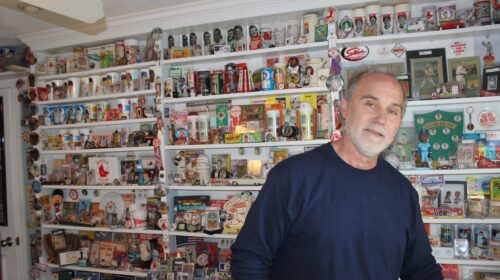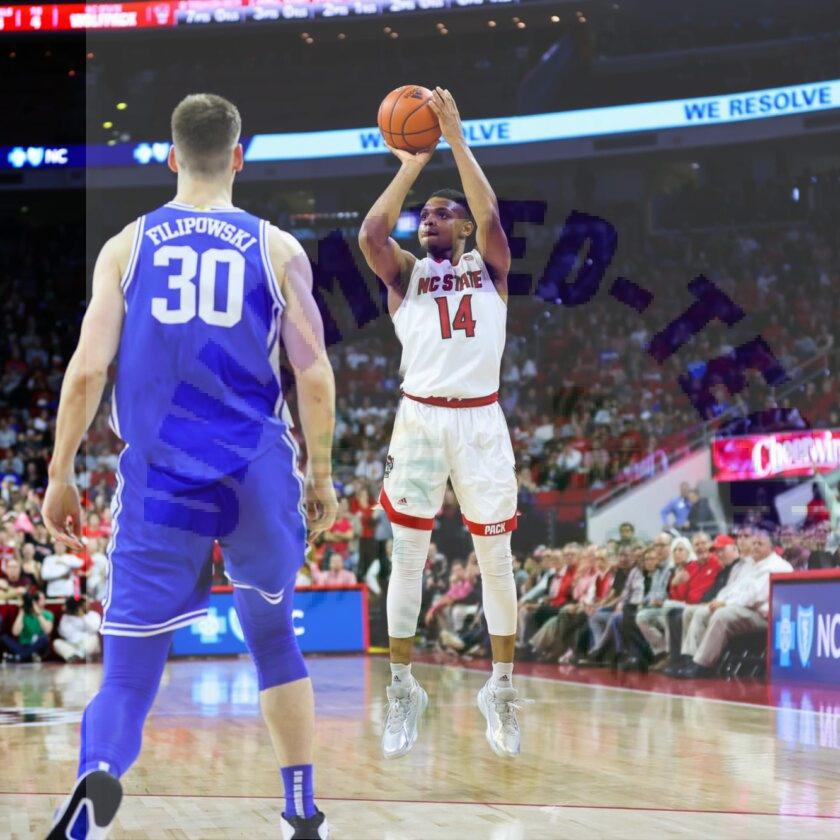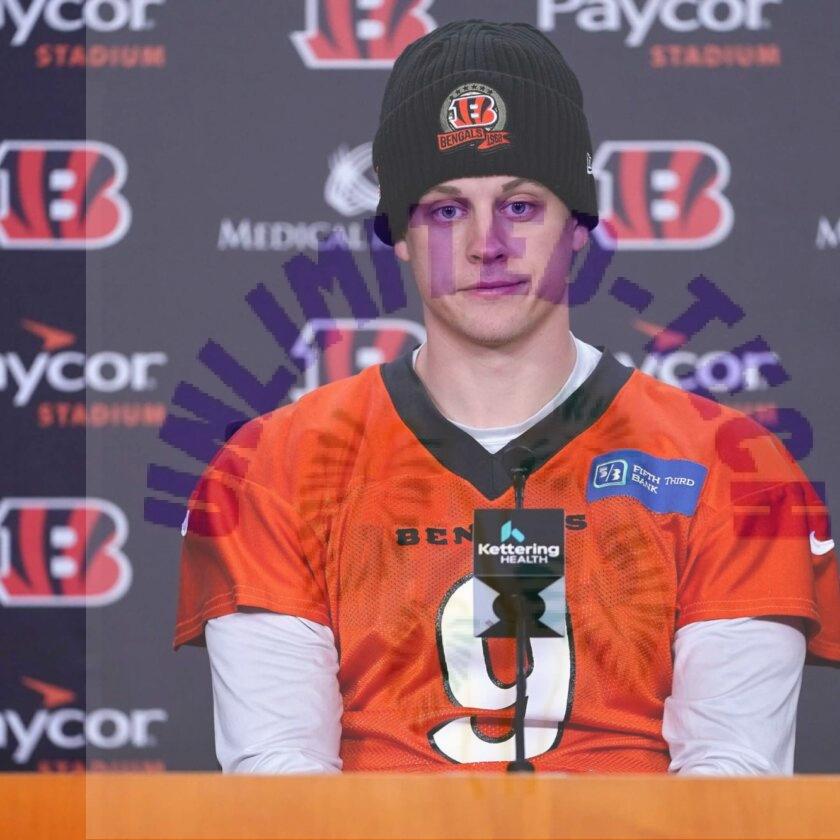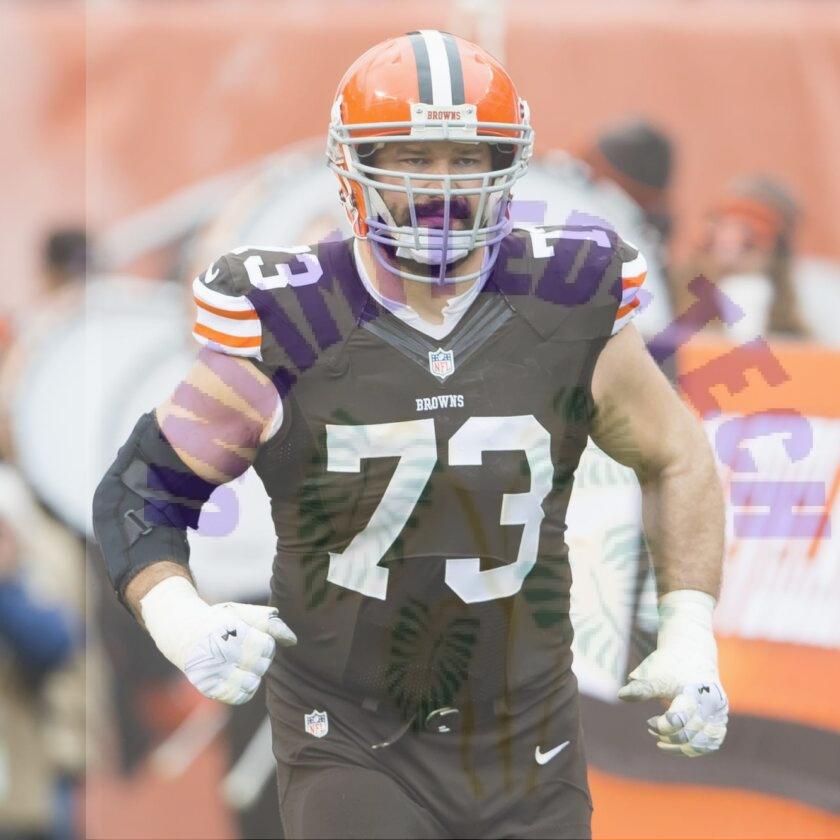Mark Hoyle has spent a lifetime building his collection of sports memorabilia and baseball cards. But the perfect Ted Williams still eludes him.
It looks like a museum exhibit. Rows of shelves line the walls, adorned with little snippets of the past. Faces stare back from their perches, guiding the history of the space. Some of those faces are smiling, some are serious, but all of them are immortalized for their fame and renown.
It isn’t a museum exhibit, however. This is the acclaimed memorabilia room of Mark Hoyle, Boston’s biggest Red Sox card collector. Even if he won’t readily admit to that.
“I don’t know if I would ever make that claim,” Hoyle admits, a tad sheepish. He runs a hand atop his head, fingers combing through thin white hair. “I’d say I’m one of the top Red Sox collectors, but not the biggest. I like the fact that people think I am, but I know a lot of guys who have damn good collections.”
Hoyle’s modesty does little to diminish the pure history in the room. Ted Williams is the most prominent and recurring figure. The Splendid Splinter’s visage inhabits nearly every corner of the room. He strikes a series of poses — in his stance at the plate, preparing for a swing, or simply hanging around the diamond. In this domain, he’s a model, posing and flexing for an audience of one.
Other members of Red Sox lore are present. Cy Young looks down with a stoic expression from a premier spot. Carl Yastrzemski sports a wry smile elsewhere, not too far from Carlton Fisk. Players from nearly every era of Red Sox baseball, from the dead-ball period to the 2004 “Idiots,” illustrate over a century of Boston baseball.
Mark Hoyle is a card collector, but the term almost feels too broad to describe his hobby. He’s been collecting since he was five years old. Cards most collectors consider vintage, Mark collected when they were first released to the public. Those childhood cards, and a heap of others, detail Mark’s memorabilia room.
“I’m almost done with this room. Then I’m probably gonna start posting some pictures on social media and whatnot.” His eyes linger on the many shelves adorning the room. “But it’s not 100 percent yet. I wanna wait ‘till I’m sure of it.”
He’s not sure, in part, because one card is missing from his shelves: the 1939 Goudey Premium Rookie Ted Williams. Hoyle has been chasing it for decades.
“It’s a tricky one, for sure,” he concedes. For all his experience, not once has he even seen this card in person — which isn’t particularly surprising, considering there are fewer than 10 known copies of the card that exist. Still, Hoyle has never been one to give up the search.
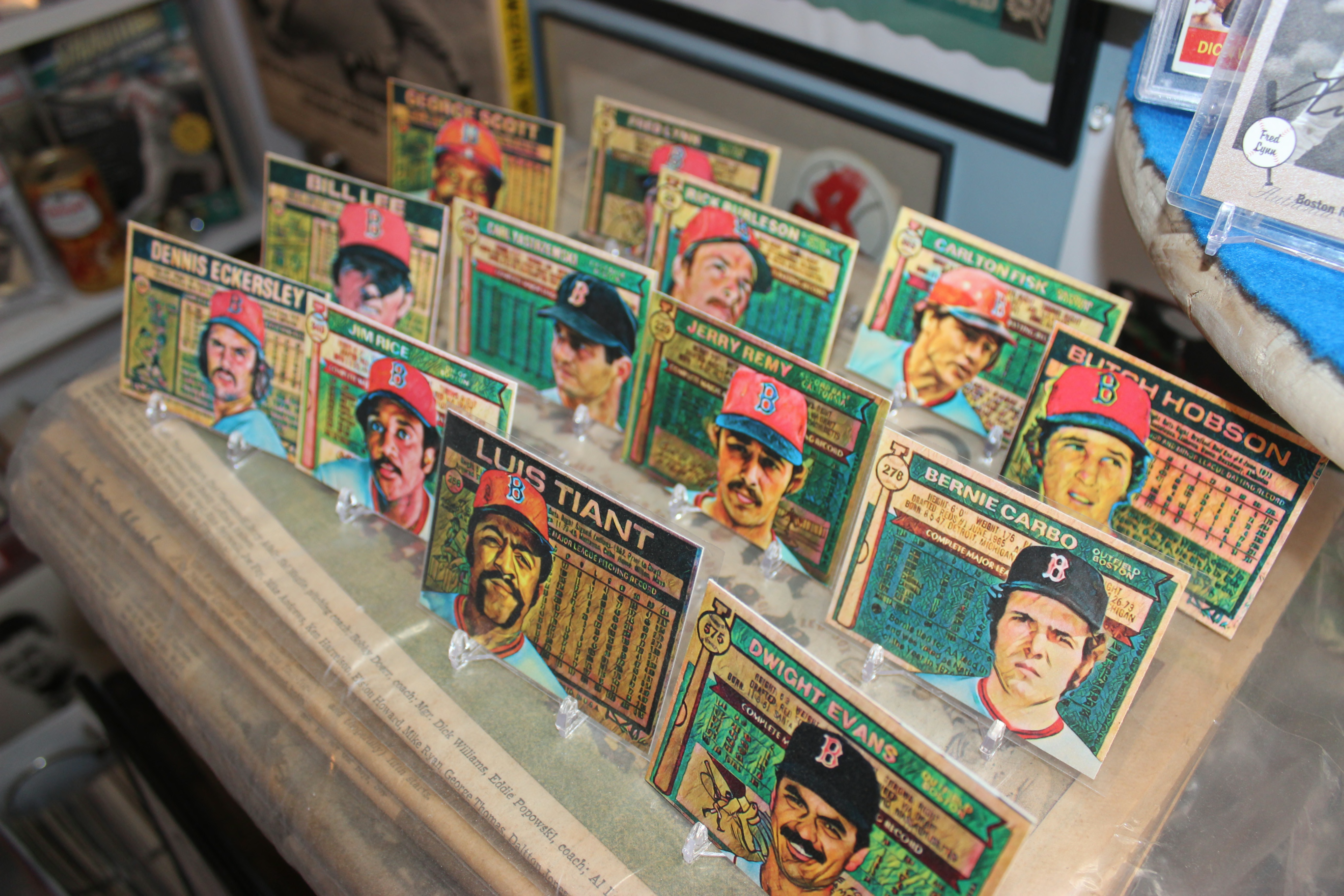
Photo Credit: Andrew Carter
A lifetime collecting baseball cards
Fifty-three years and counting. That’s how long Hoyle has been collecting baseball cards. He doesn’t remember his first card, but he does remember his first set — the 1971 Red Sox team. He figures he’s had them since childhood.
“My mother worked at the only store in town I lived in that sold baseball cards,” Hoyle, a Norton native, reminisces. “It was a pharmacy in the center of town. I would go in there with my dad whenever he would pick her up from work, and the owner would give me a pack.”
Back then, packs were a nickel a pop. Hoyle remembers them going up to a dime in 1971. They maintained that price range throughout the 80s, cheap enough for Hoyle and fellow hobbyists to purchase with allowances and part-time salaries. It helped that baseball was a hugely popular sport.
“Baseball was a big thing in my neighborhood,” Hoyle remembers. “It was the 70s, so for fun we’d play sports as soon as we got out of school, all the way until it got dark. Basketball, football, baseball, you name it, we played it. But baseball was the big one.”
Hoyle remembers collecting as early as age five. He continued to collect up until his sophomore year of high school. There was a brief lull when the world came calling. “I kinda got out of it for a while. You’re in college, you’re starting to work, you’re getting a family started. It was a lot, but I was never 100 percent out of it.”
Mark works as an independent contractor, so he controls his own hours. When he started, it was six to seven days a week working in the field and managing contracts, on top of raising a family. Time spent collecting was a luxury as a 35-year-old with four kids running around the house. He was only truly ever able to indulge in the hobby when his children became involved. “Both my sons collected for a while, so I would bring them to a show, grab some stuff for myself, and throw it in a box in the closet. I kept all my old stuff.”
Though his commitment waned at times, he still found means of collecting. He’d visit the old pharmacy a few times when he was older to collect when he could. A salesman at the pharmacy who worked with his mother would swing by once a year with an entire set of cards as a gift for Hoyle. Cards just had a way of finding him.
That collection of cards Hoyle kept would prove useful later on. “Maybe about 12 years ago — it was a rainy Saturday afternoon, I was hopping around on the internet — I found baseball card blogs. I started reading them, and I started communicating with these guys. And it’s like, ‘These guys are my age!’”
Hoyle’s hobby “exploded” when he got on Twitter. “I actually meet up with people, and we go all over the country. I become friends with these guys, we go to baseball games, we go to the Hall of Fame… and it’s all just through collecting cards.”
Mark’s managed to secure plenty of time for collecting now. These days, Mark isn’t in the field every day for work. He can leave a job at three in the afternoon, pick up some finds during his break, and be back on site at nine in the evening. He doesn’t work weekends, either. “I’m the boss, so I don’t get yelled at,” he laughs.
Not even the pandemic could disconnect Hoyle from his community of fellow card collectors. On Saturday mornings, the group would schedule a Zoom meeting and talk shop with one another. “It would be 30 guys on there, and you could just come and go for about four or so hours. Just talking about cards.”
“One of the guys works as a lawyer, and he uses his firm’s Zoom to put as many people on the call as he wants, since they’re closed on Saturdays.” Hoyle chuckles. “It’s pretty cool.”
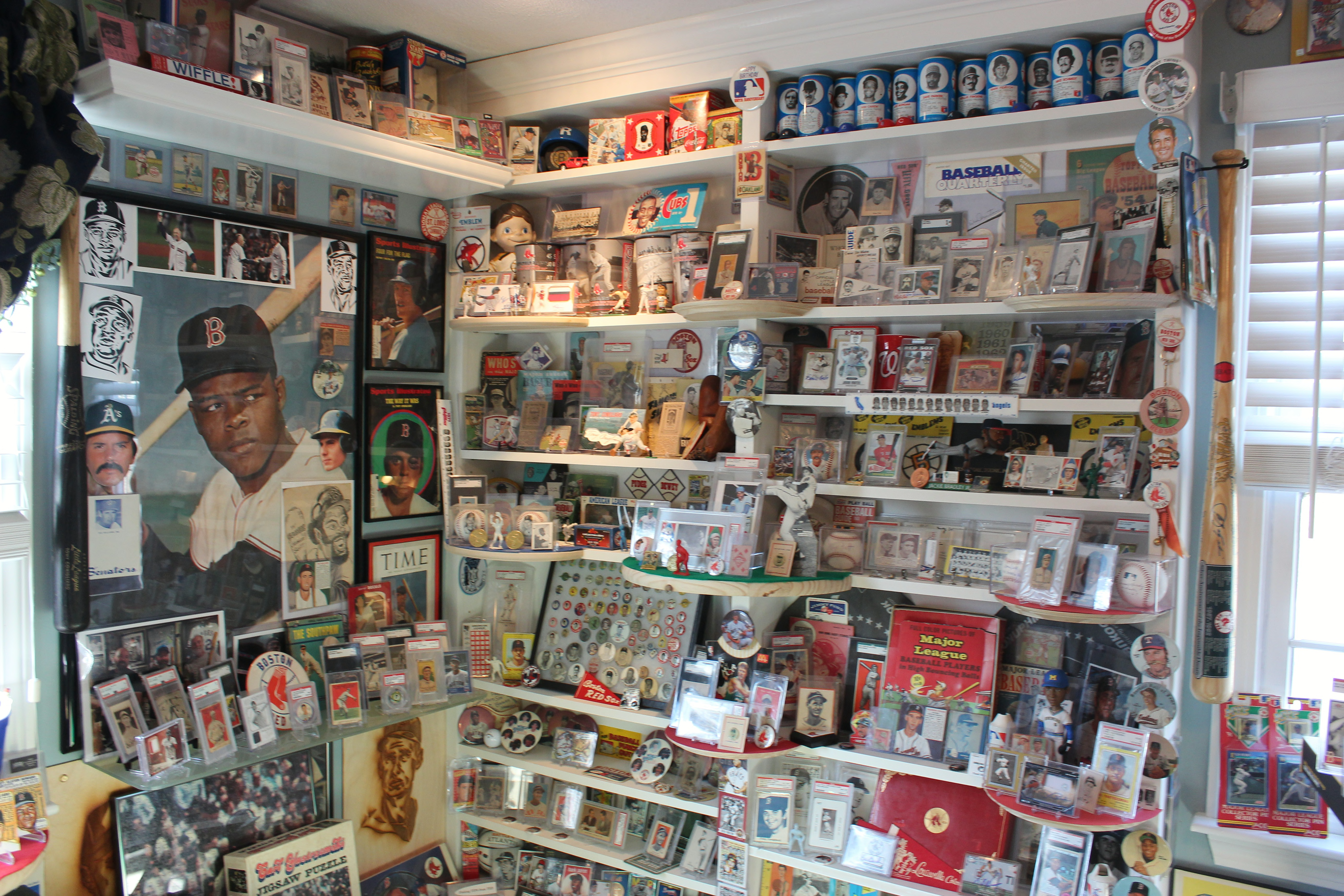
Photo Credit: Andrew Carter
The perfect Ted Williams
The 1939 Goudey Premium Rookie Ted Williams. That’s the card Hoyle is currently locked on. Plastered on the card’s cover, photos of it show, Williams stares just beyond the camera, touting a serious squint. He’s frozen in mid-swing, contorting his body as his bat pokes out from his back at an almost perfect 180-degree angle. His name is printed in big, black cursive near the bottom.
“It’s more the size of a postcard,” Hoyle knows the dimensions and history of the card so well, you’d think he’d have already owned it. “It was put up by Goudey in ‘39. It was a premium — what you did was if you bought cards over the counter, you kept the wrappers. Once you got ten wrappers, you turned them in and they would hand you this premium.”
They’re insanely difficult to find, even for someone as well-connected as Hoyle. According to Hoyle, the 1939 Goudey Ted Williams probably goes for around five-figures. And while Hoyle is an avid fan, he isn’t looking to sink that kind of money into a card.
That doesn’t mean he’ll give up. “Ted Williams is the epitome of the history of the Red Sox. I was actually talking to a guy recently who mentioned Bob Feller, who lost three of his prime years to military service, and that got me thinking about how Ted lost five of his to the military. His stats are incredible as they are, but if he played those five years, he would have the home run record, I believe. You can’t even imagine.”
Hoyle isn’t without help. “I actually have a buddy who’s looking for the same card. We talked about going halves on it. We’ll pass it back every six months so that we’d each have it for a little while.”
That buddy is Matt Walker, fellow Red Sox collector and Ted Williams superfan. “I was a Red Sox fan… growing up I was a Wade Boggs and Roger Clemens fan, so I’d always see them whenever they came and played the Orioles. I was always connected to the team.”
“I bought my first card of [Williams] in 2013,” Walker recalls. “It started little by little. I just loved how he was the man in Boston. He’s got some bad stories, particularly with the media, but he did a lot of great things around the city. He would go to visit children’s hospitals… his story is fascinating, and so was his approach to hitting.”
Walker, a former high school ballplayer himself, took a lot from Williams’ philosophy on hitting. He’s read Williams’ book, The Science of Hitting, numerous times. His play, stature, and commitment to the city cemented Williams in Walker’s memory. “It was the love for the Red Sox combined with the love for the best player who ever played for that organization.”
“I get asked often, ‘How do you get excited over a guy you never watched play?’ And I concede that it’s kind of a good point, but when you watch how he approached the game, and how he approached hitting, it was just fascinating to me. And I just thought, ‘This is it.’”
Walker first met Hoyle over Twitter, when Hoyle was posting about Boston findings when Matt was still perusing. “We just kind of started chatting. We officially met in 2019 at the Shriners show in Boston, but we’d sent RAKs to each other before then. Mark also personally collects Jackie Jensen cards, and I’d sent him one I’d seen from an antique shop I’d found a while ago. We’ve probably exchanged four, five, six times just back and forth.”
Walker laughs a bit. “Mark knows a lot. I ask him a lot of questions, and when he answers, I’m like ‘How do you even know that?’ He’s so well-educated on the Red Sox and their memorabilia.”
It’s that mutual love for the Sox and for Williams that drives Walker and Hoyle to collaborate on finding the 1939 Goudey. “It’s an extremely elusive card. When they do pop up, it’s always at an auction. For one in really, really bad condition, it’ll probably go for around three thousand [dollars]. For one in decent condition, that’s closer to eight to 10. It’s just really hard to find.”
Walker and Hoyle have exchanged multiple notes and leads, aiming to pin down an affordable card in good condition. “There was one, a number of months ago, and we both went in on it. My offer was a little higher, so he was like, ‘You go ahead with it, I’ll back off.’ We didn’t get it, obviously, but that’s how it goes.”
“That’s kind of what we do… we just support each other.”
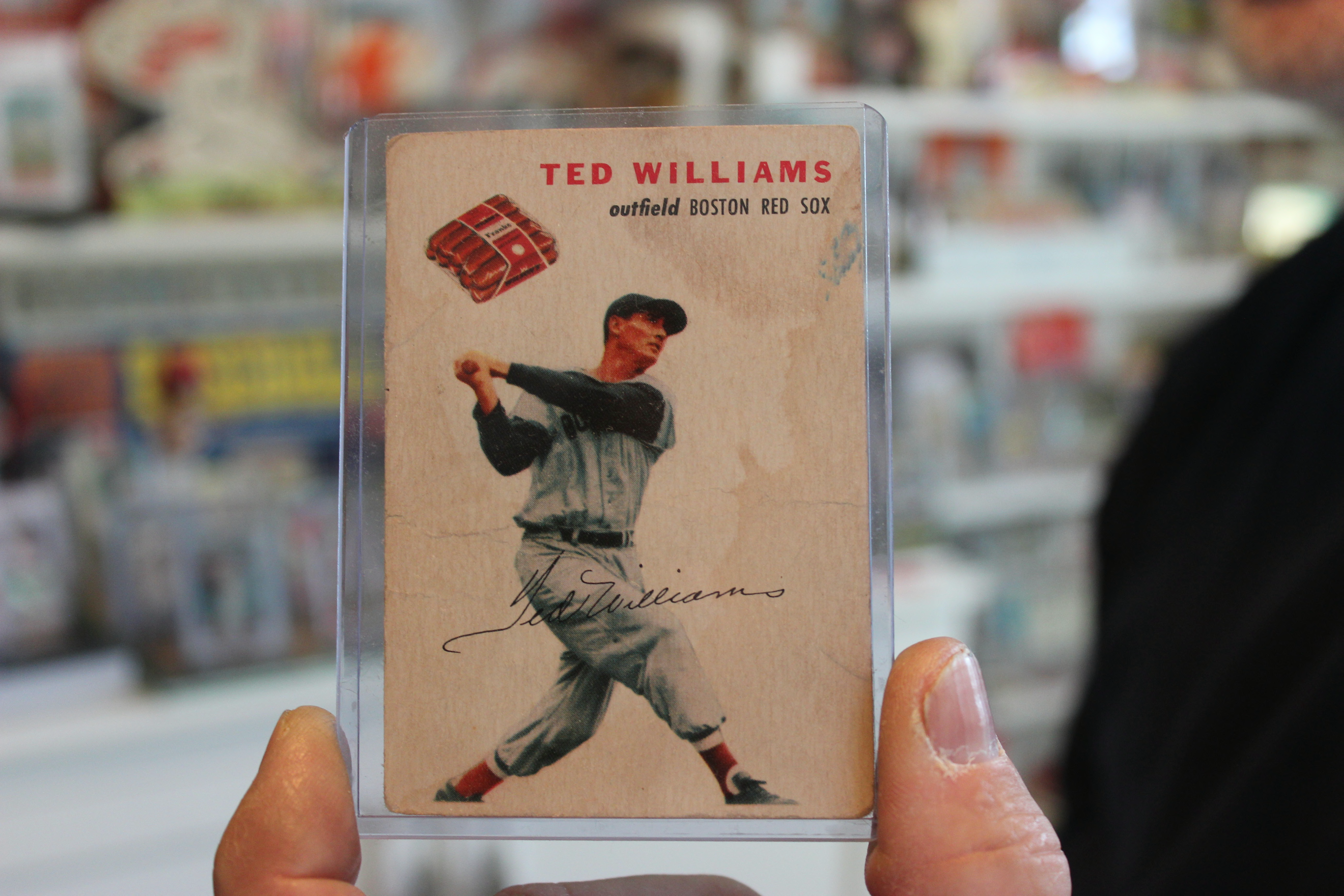
Photo Credit: Andrew Carter
The hunt continues
At Hoyle’s age, the process of finding and acquiring a card isn’t as kinetic as it used to be. Whereas his searching grounds might have once been the many stalls and booths at the old Mansfield shows or the annual Boston Shriners, time and experience have since moved Hoyle to a different medium — the internet.
Hoyle, sitting comfortably in his memorabilia room with a Celtics game playing as white noise, hops on his iPad and gets to it. eBay is his first stop, and his eyes roam over the multiple vintage cards with a trained and practiced ease. His thoughts are more discerning — ‘How’s this one? Is it a fair sell? What’s the condition? Would this complete a set of mine?
After an hour, Hoyle figures that a break is in order. He takes to Twitter, where his fellow online collectors detail their newest finds and experiences. He retweets a post from Cliff Wollaston — an Orioles fan and fellow veteran collector — showing off a Mike Epstein card, signed by the former Oriole himself.
After a few more idle minutes, Hoyle exits his front door and checks his mail. Even this is part of the search — there’s no telling whether or not a friend sent him precisely the card he was looking for or just another cool card in general. These random gifts are known throughout the community as RAKs; Random Acts of Kindness.
Hoyle makes a few calls. Walker might have made some leeway with the 1939 Goudey, so he calls him up to check. No results on his end, Walker reports, but Hoyle is quick to assure him that it’s fine. Card collecting can be as much about patience as it is tenacity. And as the years have gone by, Hoyle has come to love the process of searching almost as much as the result.
“Sometimes, you go to card shows, and you don’t even have a list, or have anything specific you’re looking for. Those shows can be better — you’re just cruising through the place, no agenda, no checklist. You’re just looking for the real oddball stuff.”
Considering the 1939 Goudey’s rarity, going to a show seems like a waste of time. So Hoyle is content with playing the long game. Scouring the internet, calling friends in his community, and checking his mail for months on end.
“There’s never a rush,” Hoyle speaks with the honed patience of a man with plenty of time to wait. “I just wait and see. I don’t really waste time thinking about the negative outcomes. It’ll come — I just have to hold out hope and keep looking.”
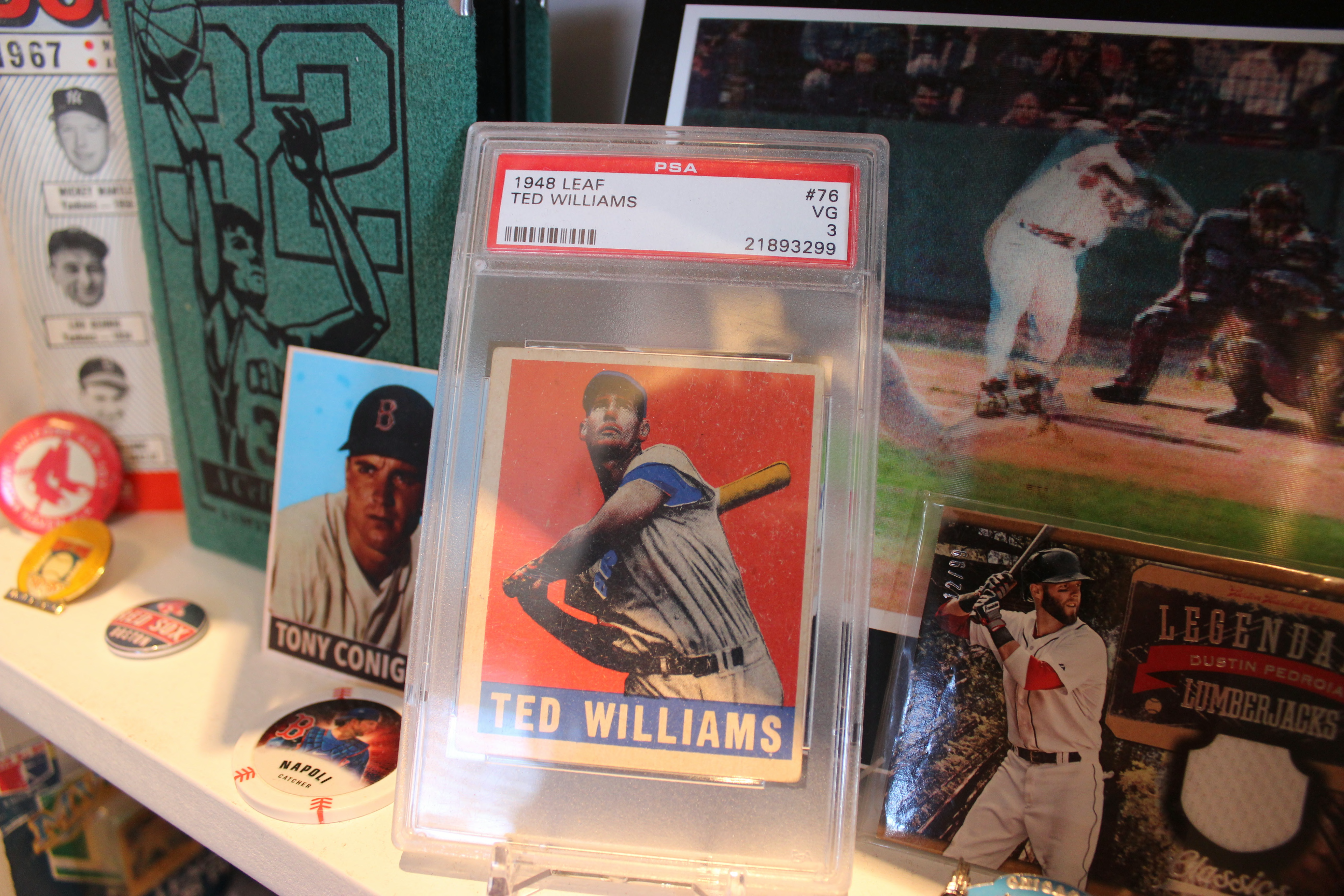
Photo Credit: Andrew Carter
A community in baseball cards
Collecting memorabilia has a way of bringing people together, in Hoyle’s eyes. Hoyle lost two of his sons to early deaths; Mark remembers finding solace in his hobby during both tragedies and using it as a means of making peace. “Those were dark days. But I remember thinking back on the memories we shared, bonding over sports and cards, and I thought to myself that those would live on forever. In that sense, they’re always with me.”
He’s used that experience to help others who have suffered similar tragedies. Acquaintances Mark has met through social media have reached out, asking how to cope with loss. “I’ve been in the worst possible place a parent can be in. Twice. If I can come back and keep on moving forward, anyone can. That’s what I tell these guys who talk to me about that kind of stuff. It hurts, but you can always keep going.”
“This community really is more than just a group of people who like sports and cards. We help each other out. We lend advice when we can. We hang out and have fun. It’s really unlike anything I think that’s out there. That’s what makes it special.”
Those acquaintances have helped Hoyle think about what might come next. Hoyle’s a bit on the older side (58 years, exactly), and though he doesn’t like thinking about it too much, there’s always that lingering thought of where his collection will eventually go. “My wife asks me that a lot,” he says with a wry smile. “Like, ‘What are you gonna do with all this stuff?’”
“I’m hoping to live for a while longer. I’m gonna keep going. I’ll probably slow down a little bit.” He pauses briefly. “I had a friend I met online seven or eight years ago. He was the same age as me. Big, big collector. He died the week before Christmas. And it really put a lot of things into perspective.”
He gestures to the room around him. “This room used to be a complete mess. Once I heard that Bill had passed away, the week after Christmas, I got to organizing it. And it was mostly because of Bill. You could kick the bucket tomorrow, and what are you gonna do with all this?”
Hoyle’s children (and his seven grandchildren) aren’t into collecting like he is. There’s no concrete plan on where the cards will go, or who he’ll give them to, but there are a few ideas. “I’ll probably stay in it until I can’t do it anymore. And then I’ll probably start to unload a few things a little at a time.”
But that’s a thought for another time. Hoyle’s estimation is that he’ll be good to go for another “10 to 15 years.”
In the short-term, Hoyle plans on heading to the annual Boston Shriners Card Show in early April. At this stage of his collecting career, he doesn’t go in looking for anything specific — he’s not expecting the 1939 Goudey to magically appear before him. The thrill of a rare find is enough to pull him in.
As of now, there’s no immediate change on the Ted Williams front. Hoyle doesn’t anticipate any movement for a while. “That’s the way it goes,” Hoyle reiterates.
Weeks, months, even a year — Hoyle is willing to wait. Baseball is a game of patience, after all. And for a man who has collected cards since he was five, patience comes as easy as hitting did for Ted.
[ad_2]

